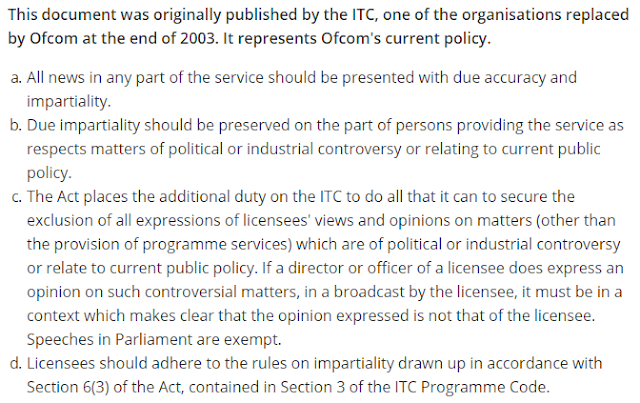- Politics
- Large events (Marathons, Royal family death/birth)
- Military
- Mass Murder in America
By law the news broadcasts must be impartial, meaning they can not manipulate the facts or have their opinion.
News Values:
Galtung and Ruge studied the news programmers over a series of weeks, and concluded that there are a set of criteria that have to be met for the news shows to feature the story. These criteria are:
1. Frequency - Events that unfold conveniently within the production cycle of a news outlet are more likely to be reported.
2. Threshold - The larger the event, the more people it affects, the more people it affects, the more likely it is to be reported.
3. Unambiguity - The Fewer ways there are of interpreting an event, the more likely it is to be reported.
4. Meaningfulness - The more culturally proximate or relevant an event is the more likely it is to be reported.
5. Consonance - If a journalist has a mental pre-image of an event, if its expected to happen, the more likely it is to be reported.
6. Unexpectedness - If an event is unexpected, it is more likely to be considered as noteworthy and therefor is more likely to be reported.
7. Continuity - Once an issue has made the news once, future events related to the original story are more likely to be reported.
8. Compositional Balance - an event that contributes to the diversity of topics reported is more likely to be covered than one that adds to a pile of similar news items.
9. Elite Nations/Regions - Events that involve elite nations or regions are more likely to be reported than those that do not.
10. Elite People - Events that involve elite people are more likely to be reported than those that do not.
11. Personification - Events that can be discussed in terms of the actions of individual actors are more likely to be reported than those that are the outcome of abstract social forces.
12. Negativity - An event with a negative outcome is more likely to be reported than one with a positive outcome.
The Gate keeping Process for Broadcast News
This diagram shows the process of creating a news programme. It starts with finding the event to report on, which means that is has to conform to one or more of the values above. If the event does not have enough of these values, then it will not be reported and will be sent to "The dustbin of history". However, if the event does have these values, then it will be able to pass through the first "Gate", though this does not mean that it will defiantly be broadcast. The next part the event must have is news sources, journalists,camera crews, witnesses, victims, family of victims etc. The problem for most events that happen is that the news channels only monitor a small amount of possible targets, for example:
- Political Buildings
- Foreign Parliament in Elite Countries
- Elite People
- Terrible Acts (Tienanmen Square Massacre)
Continuity system:
Though the news claims to give you an un-manipulated account of what had happened in a event, and how it affected those involved/around it, they still use techniques that are most commonly used in films or TV shows, such as the continuity system.
In conclusion, I believe that this proves that the news is not as transparent as they claim to be. As far as a window goes, it is more of a opaque, cracked glass window.



No comments:
Post a Comment